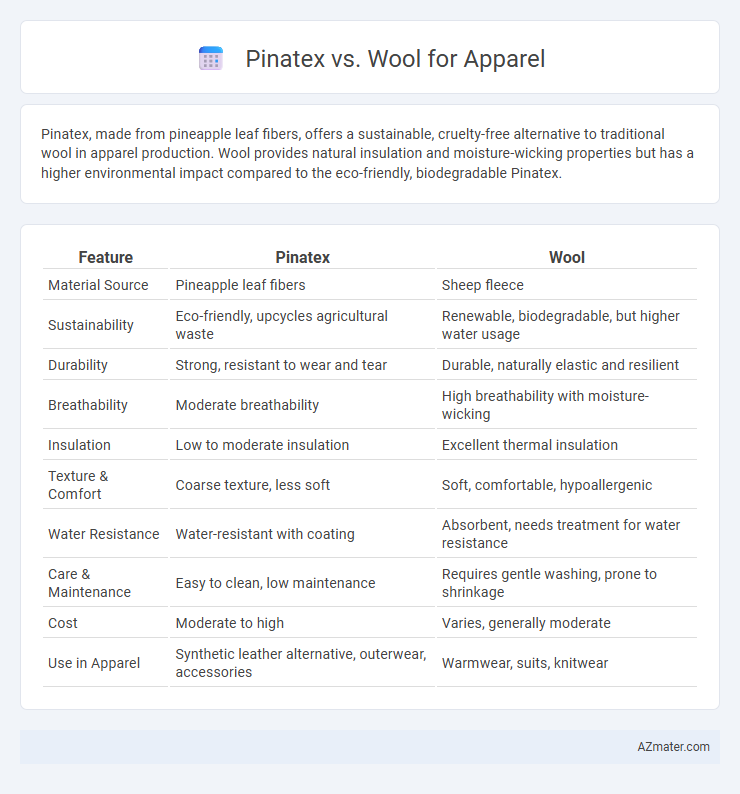Pinatex, made from pineapple leaf fibers, offers a sustainable, cruelty-free alternative to traditional wool in apparel production. Wool provides natural insulation and moisture-wicking properties but has a higher environmental impact compared to the eco-friendly, biodegradable Pinatex.
Table of Comparison
| Feature | Pinatex | Wool |
|---|---|---|
| Material Source | Pineapple leaf fibers | Sheep fleece |
| Sustainability | Eco-friendly, upcycles agricultural waste | Renewable, biodegradable, but higher water usage |
| Durability | Strong, resistant to wear and tear | Durable, naturally elastic and resilient |
| Breathability | Moderate breathability | High breathability with moisture-wicking |
| Insulation | Low to moderate insulation | Excellent thermal insulation |
| Texture & Comfort | Coarse texture, less soft | Soft, comfortable, hypoallergenic |
| Water Resistance | Water-resistant with coating | Absorbent, needs treatment for water resistance |
| Care & Maintenance | Easy to clean, low maintenance | Requires gentle washing, prone to shrinkage |
| Cost | Moderate to high | Varies, generally moderate |
| Use in Apparel | Synthetic leather alternative, outerwear, accessories | Warmwear, suits, knitwear |
Introduction: Piñatex vs Wool in Apparel
Pinatex, a sustainable leather alternative derived from pineapple leaf fibers, offers a cruelty-free and eco-friendly option for apparel manufacturing, promoting reduced environmental impact compared to traditional wool. Wool, a natural fiber obtained from sheep, is valued for its warmth, moisture-wicking properties, and biodegradability, making it a renewable but resource-intensive material. The choice between Pinatex and wool involves balancing sustainability, performance, and ethical considerations in textile production.
Material Origins and Sustainability
Pinatex, derived from pineapple leaf fibers, offers a sustainable alternative by utilizing agricultural waste, reducing reliance on animal agriculture and minimizing environmental impact compared to traditional wool. Wool, sourced from sheep, provides natural insulation and biodegradability but involves higher resource consumption, such as water, land, and methane emissions, impacting its sustainability profile. Pinatex's plant-based origin contributes to circular fashion initiatives, emphasizing renewable materials and reduced carbon footprint in apparel production.
Production Processes Compared
Pinatex production involves extracting fibers from pineapple leaves, which are then processed into non-woven textiles using environmentally friendly techniques, reducing waste and chemical use compared to conventional fabrics. Wool production requires shearing sheep, cleaning, carding, spinning, and weaving, processes that often consume significant water and energy and can contribute to greenhouse gas emissions. The Pinatex method offers a sustainable alternative by utilizing agricultural byproducts and requiring less intensive resource input in comparison to traditional wool textile manufacturing.
Environmental Impact Assessment
Pinatex, a sustainable alternative made from pineapple leaf fibers, has a significantly lower environmental impact compared to traditional wool, as it requires no water-intensive animal farming or methane-emitting livestock. Wool production contributes to land degradation, high greenhouse gas emissions, and intensive resource use, while Pinatex utilizes agricultural waste, reducing landfill burden and promoting circular economy principles. Life cycle assessments reveal Pinatex's reduced carbon footprint and water consumption, positioning it as an eco-friendly choice for apparel manufacturers.
Comfort and Wearability
Pinatex offers exceptional breathability and lightweight flexibility, making it ideal for comfortable, long-wear apparel, especially in warm climates. Wool provides superior insulation and moisture-wicking properties, maintaining warmth and comfort in cooler conditions while allowing for natural stretch. Both materials deliver distinct wearability benefits, with Pinatex excelling in vegan and sustainable fashion and wool offering durability and thermal regulation.
Durability and Longevity
Pinatex, made from pineapple leaf fibers, offers strong tensile strength and water resistance, making it a durable alternative for apparel with natural breathability. Wool provides exceptional resilience and elasticity, maintaining shape and insulating properties even after extended wear and multiple washes. Both materials deliver longevity, but wool's natural ability to self-clean and resist odors enhances its lifespan compared to Pinatex.
Style and Aesthetic Versatility
Pinatex offers a unique, textured aesthetic derived from pineapple leaf fibers, providing a modern, eco-conscious alternative with natural variations and a matte finish ideal for casual and avant-garde styles. Wool delivers timeless elegance and superior drape with its smooth surface and rich color depth, making it highly versatile for both formal and everyday apparel. Each material lends distinct visual appeal, with Pinatex emphasizing sustainability and novelty, while wool embodies classic sophistication and adaptability.
Cost and Market Availability
Pinatex offers a cost-effective alternative to wool, with prices generally lower due to its sustainable production from pineapple leaf fibers, making it accessible for eco-conscious fashion brands. Wool remains widely available with established supply chains but tends to be more expensive because of animal husbandry and processing costs. Market availability for Pinatex is rapidly growing in niche sustainable apparel sectors, while wool dominates traditional and luxury garment markets.
Ethical Considerations
Pinatex, made from sustainable pineapple leaf fibers, offers an eco-friendly and cruelty-free alternative to traditional wool, reducing animal harm and environmental impact. Wool production often involves animal welfare concerns, including shearing practices and land use issues that contribute to greenhouse gas emissions. Choosing Pinatex supports ethical fashion by minimizing resource consumption and promoting biodegradable, plant-based materials.
Conclusion: Choosing the Right Fabric
Pinatex offers a sustainable alternative made from pineapple leaf fibers, providing durability and eco-friendliness with a distinctive texture suitable for fashion-conscious consumers. Wool, known for its natural insulation, breathability, and biodegradability, remains a staple in traditional apparel for warmth and comfort. Selecting the right fabric depends on specific needs: Pinatex excels in vegan, water-resistant options, while wool outperforms in thermal regulation and long-lasting wear.

Infographic: Piñatex vs Wool for Apparel
 azmater.com
azmater.com